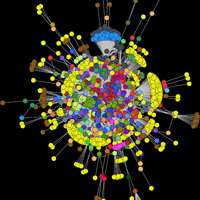What does Twitter have to do with the human brain?

(PhysOrg.com) -- We like to think the human brain is special, something different from other brains and information processing systems, but a Cambridge professor is set to test that assumption – by conducting a live experiment using Twitter.
Speaking at Cambridge Science Festival next week, Professor Ed Bullmore will describe how new ways of looking at the network organisation of the human brain show that it has a surprising amount in common with the worm brain, computer chips, stock markets, and many other complex systems.
According to Professor Bullmore: "We know that the brain is fiendishly complicated in detail. Our brains have billions of nerve cells connected by trillions of synapses, so trying to figure out how it works by focusing on one cell or one synapse at a time is impossible.
"But we can use some simple mathematics to give us a different vision of the brain - losing sight of many of the details but clarifying the complex overall pattern of connections that make up a brain network."
Viewed this way, it turns out that human brain networks represent a balance between high efficiency of information transfer and low connection cost.
Professor Bullmore will explain how different types of thinking seem to depend on different patterns of network connection and how human brains can shift rapidly between different network configurations over time. He will also show how this new research on normal brain function is beginning to change the way we think about mental health disorders, such as schizophrenia, and their treatment.
"This way of looking at the human brain tells us a lot about how it is organised in its own right. But it also allows us to ask some more general questions that might not have made sense a few years ago, such as what's special about the human brain compared to other networks?
"You might say we are 'taking the brain out of the skull' to look at it directly in comparison to many superficially different information processing systems," says Professor Bullmore.
To demonstrate this directly, Professor Bullmore will be conducting a live experiment during his talk at Cambridge Science Festival, the UK's largest free science festival.
This interdisciplinary public engagement project is a collaboration between Cambridge Neuroscience and the University Communications Office.
Members of the audience and other Twitter users will be encouraged to tweet about the brain and other networks, using the tag #csftwitterbrain, and at the end of his talk Professor Bullmore will show how the resulting Twitter network can be compared to the human brain network.
"The point of the experiment is not to show that the human brain network is the same as a Twitter network - I would be surprised if that was the result, but it will be interesting to see what happens!
"The more important point is to show how this new way of looking at the brain can perhaps help us make some unexpected and interesting connections between the networks in our heads and the many other networks around us."
More information: Professor Bullmore's talk "Brains, minds and their connectivity" is on Thursday, March 17 from 6.30-7.30 pm at the Babbage Lecture Theatre, University of Cambridge. Free, suitable for ages 16+. The talk is part of the Cambridge Science Festival, the UK's largest free science festival. It runs from March 14-27 with more than 150 mostly free events.
Provided by University of Cambridge

















